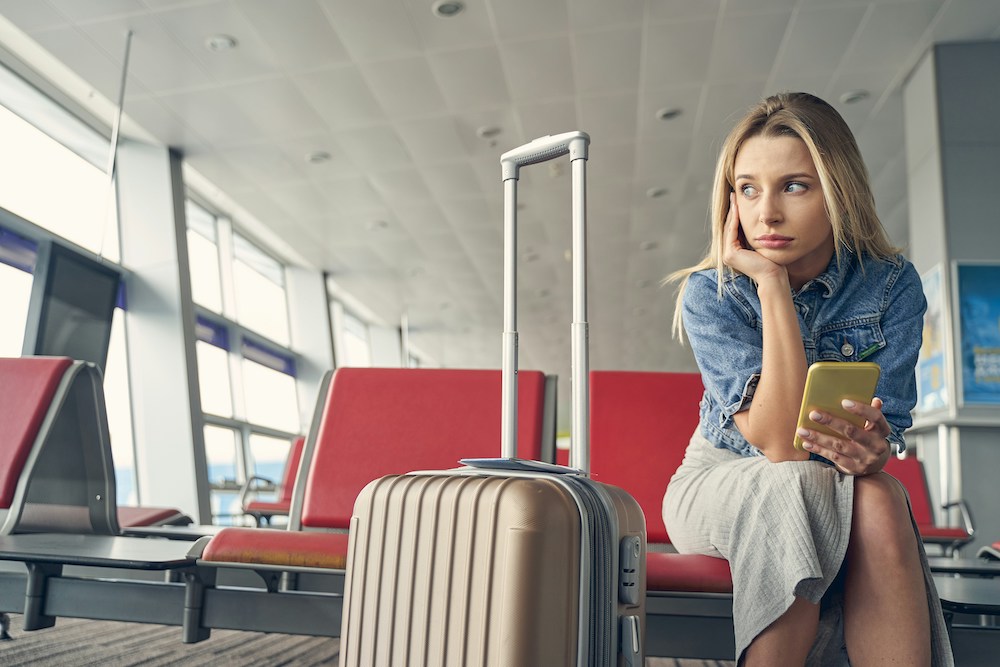What your attendees actually need when they’re stranded
Reading Time: 6 minutes
That sinking feeling when your VIPs are stranded is all too real. But what if a 4-hour layover wasn’t a crisis, but a competitive advantage? Here’s how to turn the industry’s biggest headache into a win for your attendees—and your sanity.
It’s the scenario that keeps every event planner up at night. The keynote speaker’s flight is delayed, threatening a gaping hole in the Day 1 agenda. A dozen attendees are stranded in a connecting hub, trickling in late, stressed, and disengaged. Your core planning team, meant to be on-site for a final walkthrough, is stuck staring at a departure board, their productivity plummeting with every passing minute.
In the world of meticulously planned events, air travel has always been the chaotic, uncontrollable variable. Flight delays are not an anomaly; they are a statistical certainty. At major hubs like Denver (DEN), Newark (EWR), and San Francisco (SFO), delay frequencies consistently hover around 30% or higher. For decades, the industry has treated this as an unavoidable cost of doing business—a problem to be mitigated with contingency plans and frantic, last-minute adjustments.
A New Perspective
What if we’ve been looking at the problem all wrong?
A new paradigm is emerging in corporate travel, one that reframes the delay not as a crisis, but as a manageable, and even productive, part of the journey. The very mega-hubs most susceptible to disruption are often the ones that have invested the most in transforming the passenger experience. This has created a powerful, yet often overlooked, strategic lever for event planners: the connecting airport.
Choosing a layover city is no longer just about flight times and cost. It’s about building resilience into your event’s travel logistics. It’s a form of insurance for your attendees’ well-being and your speakers’ punctuality. By strategically routing your travelers through airports designed for productivity, comfort, and connectivity, you can turn hours of frustrating downtime into an opportunity for focused work, genuine relaxation, or a positive first taste of the host region’s culture. This isn’t just about logistics; it’s about attendee experience management, and it starts the moment they leave for your event.
For the modern meeting planner, mastering the art of the strategic delay is the next frontier in creating seamless, successful, and human-centric events. It’s time to stop planning around delays and start planning for them.
From Hellscape to Paradise
Before planners can leverage the airport, they have to understand what separates a soul-crushing layover from a productive pause. The modern business traveler’s needs during a delay come down to four pillars: Work, Eat, Entertain, Relax.
For event planners, these aren’t just amenities—they’re critical infrastructure. Attendees stuck in transit are still in your care. A hub with reliable Wi-Fi, restorative spaces, and recognizable local flavor isn’t fluff; it’s part of the attendee experience you’re curating.
The planner who factors that into site selection—and even pre-event communication—adds tangible value: comfort, predictability, and maybe even delight.
The Mobile Office: Seamless Productivity. The number one requirement is the ability to work effectively. This goes beyond a spotty Wi-Fi signal. A delay-proof airport offers enterprise-grade connectivity, abundant and functional power outlets, and, crucially, a spectrum of workspaces. This ranges from quiet zones for focused tasks to private, sound-proofed pods for confidential calls—ensuring your attendees and team can stay on top of their responsibilities, even when their itinerary is not.
The Culinary Connection: A Taste of Place. Airport food has shed its reputation for stale sandwiches and greasy fast food. The best airports now act as culinary embassies for their cities, featuring outposts of beloved local restaurants and farm-to-table concepts. For an event planner, this is a powerful tool. An attendee’s first meal during a layover can set the tone, offering an authentic and positive introduction to the region’s culture long before they reach the registration desk.
The Inspiration Break: Beyond the Gate. A terminal is no longer just a conduit; it’s a destination. Leading airports have invested heavily in arts and culture programs, transforming their concourses into galleries and performance spaces. These features provide a much-needed mental break from the stress of travel, allowing attendees to arrive at your event feeling refreshed and inspired, not drained and screen-fatigued.
The Recharge Zone: Prioritizing Well-Being. The physical and mental toll of travel is immense. The most forward-thinking airports recognize this and provide dedicated spaces for rest and relaxation. From premium lounges with shower suites to private, rentable nap rooms and even yoga studios, these amenities are essential for mitigating travel fatigue. An attendee who has had a chance to genuinely rest during a delay is one who will show up to your opening session alert, engaged, and ready to participate.
FURTHER READING: America’s Best Airports to Be Stranded In
Protect Your Most Valuable Assets. For keynote speakers, VIPs, and critical team members, insist on booking their travel through these premier hubs. The ability to offer a speaker a private Minute Suite at Detroit Metropolitan Wayne County Airport (DTW) or guarantee them world-class Wi-Fi at San Francisco International Airport (SFO) is a tangible benefit that protects your agenda and shows a high level of care.
Leverage Lounge Access as a Perk. For your internal team, investigate corporate credit cards that provide lounge access (e.g., American Express Platinum for Centurion Lounges) or consider purchasing day passes for key personnel. The cost is minimal compared to the lost productivity and accumulated stress of a long delay in a crowded terminal.
Build a Better Buffer. Encouraging attendees to build buffer time into their travel is standard advice. But that advice is far more palatable when the buffer time can be spent productively. A five-hour layover at an airport with Jabbrrbox pods and award-winning food is a working afternoon; a five-hour layover elsewhere is a write-off.
The Final Boarding Call: Why the Journey Is the Destination
The landscape of business travel has fundamentally changed. Disruption is the new normal. For meeting and event planners, this requires a shift in mindset—from reactive problem-solving to proactive, strategic planning that encompasses the entire attendee journey.
The airport is no longer a neutral space; it is an active participant in your event’s success or failure. By understanding the distinct advantages of hubs like Minneapolis-St. Paul, Detroit, San Francisco, and Seattle, you can make intelligent, resilient choices that mitigate risk, enhance attendee well-being, and ensure your team arrives on-site prepared, productive, and positive. In an industry where experience is everything, the most successful events will be those that begin long before anyone steps into the ballroom. They will begin with a strategic delay.
By evaluating potential travel routes through this lens, you can transform a logistical liability into a strategic asset that enhances attendee satisfaction and protects your event’s bottom line.
Any thoughts, opinions, or news? Please share them with me at vince@meetingsevents.com.
Photo by GETTY IMAGES for Unsplash+





